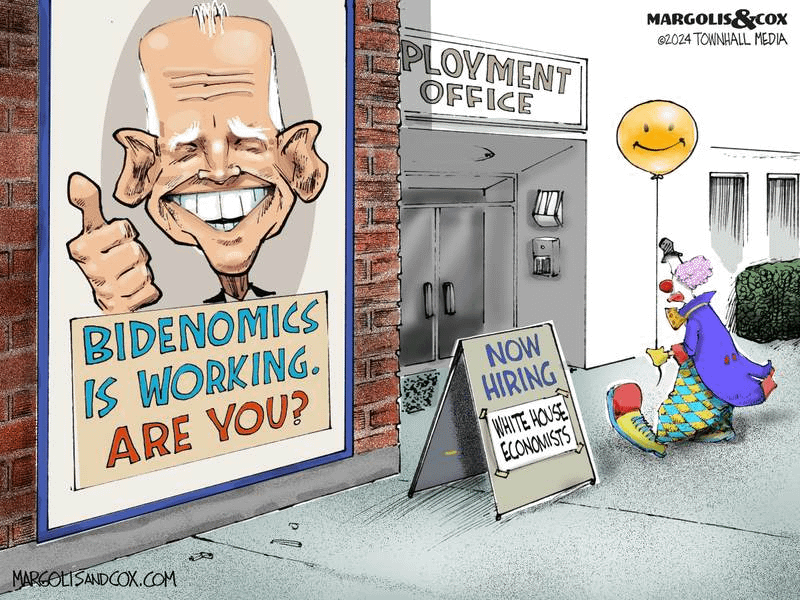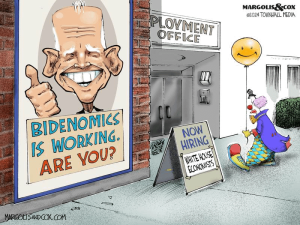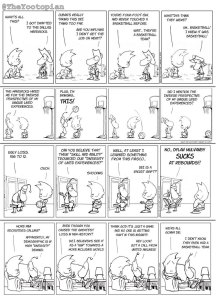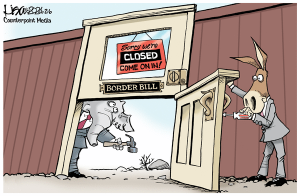2024-03-18 10:00:30
We have been following this case and story from its inception as it involves suppression by the Biden Administration of social media speech Biden and his cronies don’t like, such as COVID-19 “disinformation” (what some people call “the truth”), facts about Hunter Biden’s laptop, and other inconvenient information.
From one of our earliest posts: Judge: States Will Get ‘Expedited Discovery’ On Biden Admin Collusion With Big Tech To Censor Conservatives:
There has been much public evidence that the Biden administration has pressured large social media and tech companies to censor political opponents under the guise of designating such speech “disinformation” or “misinformation.”
On May 5, 2022, the states of Missouri and Louisiana filed a Complaint alleging that such collusion violated, among other things, its citizens first amendment rights. The defendants included not only senior administration officials, but also the head of the administrations planned and then disbanded ministry of information, Nina Jankowicz.
The Complaint asserted:
2. A private entity violates the First Amendment “if the government coerces or induces it to take action the government itself would not be permitted to do, such as censor expression of a lawful viewpoint.” Biden v. Knight First Amendment Institute at Columbia Univ., 141 S. Ct. 1220, 1226 (2021) (Thomas, J., concurring). “The government cannot accomplish through threats of adverse government action what the Constitution prohibits it from doing directly.” Id.
3. That is exactly what has occurred over the past several years, beginning with express and implied threats from government officials and culminating in the Biden Administration’s open and explicit censorship programs. Having threatened and cajoled social-media platforms for years to censor viewpoints and speakers disfavored by the Left, senior government officials in the Executive Branch have moved into a phase of open collusion with social-media companies to suppress disfavored speakers, viewpoints, and content on social-media platforms under the Orwellian guise of halting so-called “disinformation,” “misinformation,” and “malinformation.”
* * *
6. As a direct result of these actions, there has been an unprecedented rise of censorship and suppression of free speech—including core political speech—on social-media platforms. Not just fringe views, but perfectly legitimate, responsible viewpoints and speakers have been unlawfully and unconstitutionally silenced in the modern public square. These actions gravely threaten the fundamental right of free speech and free discourse for virtually all citizens in Missouri, Louisiana, and America, both on social media and elsewhere.
[emphasis added]
The Plaintiffs also filed a Motion for Preliminary Injunction asking the court to order the Biden Administration to stop coercing social media companies. During its consideration of Plaintiffs’ Motion, the court ordered expedited discovery, which was a real breakthrough in the case:
🚨 BREAKING: A federal court granted our request for discovery & documents from top ranking Biden officials & social media companies to get to the bottom of their collusion to suppress & censor free speech.
No one has had the chance to look under the hood before – now we do. pic.twitter.com/TzrxtC3piN
— Eric Schmitt (@Eric_Schmitt) July 12, 2022
This discovery order led to the now-infamous deposition of Dr. Fauci, where Fauci stated “I don’t recall” 174 times when asked whether he had communicated with various social media companies.
Amy Howe over at SCOTUSBLOG has a great summary of what happened next:
On July 4, 2023, U.S. District Judge Terry Doughty agreed with the challengers that federal government officials had violated the First Amendment by “coercing” or “significantly encouraging” the content moderation decisions of social media platforms, thereby transforming those decisions into actions by the government.
Doughty issued an order that limited communications between the White House and several other government agencies with social media companies about virtually all content.
Of course, the Biden Administration didn’t like that order and wanted to keep coercing social media companies to take down posts unfriendly to the administration, so they immediately appealed:
The Biden administration went to the 5th Circuit [U.S. Court of Appeals], which largely upheld Doughty’s order. It characterized the conduct at the center of the case as a “coordinated campaign” “orchestrated by federal officials that jeopardized a fundamental aspect of American life.” But the court of appeals narrowed Doughty’s order limiting communication to a smaller group of officials, including the White House, the Surgeon General, the CDC, and the FBI.
Well, of course the Administration didn’t like that either, but instead of simply asking the Supreme Court to take the case, the Administration instead asked for an immediate stay of Judge Doughty’s Injunction Order, which, of course, the Fifth Circuit had largely affirmed.
And, incredibly, the Court granted the stay, converted the stay application to a request for the Court to review the case, and agreed to review the case, all on the same day, October 20, 2023!
Importantly, Justices Alito, Gorsuch, and Thomas dissented from the Court’s grant of a stay, and issued a rare separate Dissent Opinion explaining their reasons for not agreeing to grant the stay of Judge Doughty’s Injunction Order.
If you read nothing else about this case, read this brief but hard-hitting five-page Dissent:
I quote the key parts here:
This case concerns what two lower courts found to be a “coordinated campaign” by high-level federal officials to suppress the expression of disfavored views on important public issues. To prevent the continuation of this campaign, these officials were enjoined from either “coerc[ing]” social media companies to engage in such censorship or “active[ly] control[ling]” those companies’ decisions about the content posted on their platforms. Today, however, a majority of the Court, without undertaking a full review of the record and without any explanation, suspends the effect of that injunction until the Court completes its review of this case, an event that may not occur until late in the spring of next year. Government censorship of private speech is antithetical to our democratic form of government, and therefore today’s decision is highly disturbing….
Despite the Government’s conspicuous failure to establish a threat of irreparable harm, the majority stays the injunction and thus allows the [Biden Administration] to persist in committing the type of First Amendment violations that the lower courts identified….
At this time in the history of our country, what the Court has done, I fear, will be seen by some as giving the Government a green light to use heavy-handed tactics to skew the presentation of views on the medium that increasingly dominates the dissemination of news. That is most unfortunate.
[citations omitted for clarity; emphasis added]
The three issues related to Judge Doughty’s Injunction Order that the Supreme Court decided to review were:
- Whether Missouri and the other Plaintiffs have standing to pursue their claims
- Whether the Government’s communications with social media companies about unfriendly posts violated the First Amendment
- Whether Judge Doughty’s Injunction Order, as modified by the 5th Circuit, was properly written, or “overbroad” (meaning curtailing too much Government speech)
Back to SCOTUSBLOG for a good summary of each issue:
“Standing” to sue
The individual challengers, the government says, have not shown that earlier decisions by social media platforms to remove or deprioritize their posts can be attributed to the government, rather than the platforms’ own independent decisions implementing their content moderation policies….
The challengers counter that there is a “clear connection” between communications by government officials pressuring platforms to suppress posts on particular topics or to adopt new content moderation policies and decisions by social media platforms to remove or deprioritize their posts.
[The challengers say] the First Amendment also shields a separate right to “speak and listen.” Specifically, the challengers explain, when the government pressures social media platforms to remove content by other speakers – such as Kennedy or Tucker Carlson – or on topics like vaccines and elections, that violates their right to receive information from those speakers or about those topics.
The merits – is the government violating the First Amendment?
The Biden administration acknowledges that the First Amendment prohibits the government from punishing someone because of their views or from trying to use its power to suppress those views, and the government cannot try to get around that restriction by compelling a private party to do so instead. “But so long as the government seeks to inform and persuade rather than to compel,” the government stresses, “its speech poses no First Amendment concern — even if government officials state their views in strong terms, and even if private actors change their speech or conduct in response.”
The challengers maintain that the government has “deeply insinuated” itself and is “deeply entangled in the platforms’ policies and independent decisionmaking.” Government officials, they say, make “relentless” demands of the social media platforms that, if unheeded, escalate to “pressure,” including threats of antitrust action against the platforms. And for their part, the challengers add, the platforms respond with “total compliance,” removing content and deplatforming users and accounts who post misinformation related to COVID-19 and vaccines.
The federal government also conspired with the platforms to remove or deprioritize speech. There were, the challengers say, “numerous, recurring, and ongoing meetings” at which government officials “discussed particular ideas and speakers with platforms, followed promptly by platforms’ suppression of those ideas and speakers.”
The terms and scope of the preliminary injunction
The lower court’s order will harm the government and the public…because it could “chill vital governmental communication” – for example, causing law enforcement officials to delay or forgo communications about national security or public safety. And it is particularly troublesome, the government concludes, when the order bars the government from “coercing” or “significantly encouraging” platforms to take action with regard to protected speech, because (as this case shows) of the lack of consensus about what those terms mean.
The challengers push back against each of the Biden administration’s arguments about the preliminary injunction. They insist that the challengers are likely to be harmed by the government’s continuing communications with social media platforms. They point to “ongoing efforts to pressure platforms to adopt censorship policies affecting both” the challengers’ “own speech and the speech of those whom they follow.”
On Monday morning, March 18, 2024, the Court heard oral argument on each issue. As Ron Coleman put it:
Today’s SCOTUS argument should be one of the most important of our times
— Ron Coleman (@RonColeman) March 18, 2024
I listened to the oral argument live, and had the following first impressions:
- Predicting the outcome of any case from the oral argument is inherently problematic, but here it is clear from the “Dissent” Opinion alluded to earlier that Justices Alito, Gorsuch, and Thomas think that the lower courts’ Injunction Order was proper. During oral argument, each Justice had questions for the two attorneys arguing the case, but the Justices didn’t seem to be changing their opinions. In fact, in one case the attorney for the Plaintiffs (supporting the Injunction Order) seemed to get off track a bit and Justice Alito sort of restated his argument for him and helped him get back on track.
- The three “liberal” Justices, Sotomayor, Kagan, and Jackson, seemed to be squarely on the Government’s side. For example, Justice Jackson offered a hypothetical about a new “teen challenge” involving jumping out of windows and suggested that the Government might even have a safety-related “duty” to order the take-down of such material or coerce social media platform companies to take such information down, which the Plaintiffs’ attorney pushed back on to some degree. Justice Kagan badgered Plaintiffs’ attorney about whether the facts of the case supported the conclusion that social media companies caved to Governmental pressure, suggested that they had acted on their own. Justice Sotomayor similarly stated that she did not think the Plaintiffs’ brief showed enough, or even any, facts indicating Governmental pressure on social media companies.
- That leaves Chief Justice Roberts and Justices Kavanaugh and Barrett, all of whom were very hard to read. Each asked a lot of questions but didn’t seem to tip their respective hands. It’s possible each is still trying to figure out where the line is between coercion (generally bad) and persuasion (generally allowed) between the Government and media companies.
We will update you, obviously once the case is decided, but even sooner if we see any insightful commentary on the case and/or oral argument. For now, some X reaction:
The Murthy vs. Missouri oral arguments were rough. #SCOTUS seemed to be falling all over itself to carve out hypothetical justifications for censorship and overreach instead of defending our constitutional right to free speech.
The remedy for false speech is true speech, not…
— AJ Kay (@AJKayWriter) March 18, 2024
1. On Murthy v Missouri govt-tech collusion/jawboning argument: Although the trial judge called it “the most massive attack against free speech in US history,” there doesn’t seem to be a SCOTUS majority ready to rule against govt actions to suppress social-media posts & accounts.
— Ilya Shapiro (@ishapiro) March 18, 2024
Donations tax deductible
to the full extent allowed by law.







